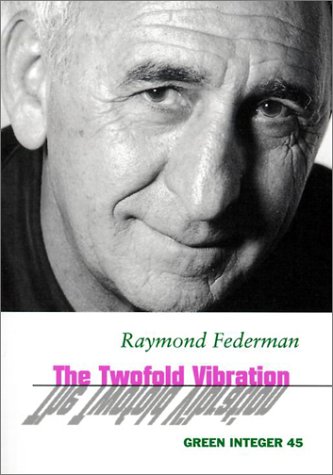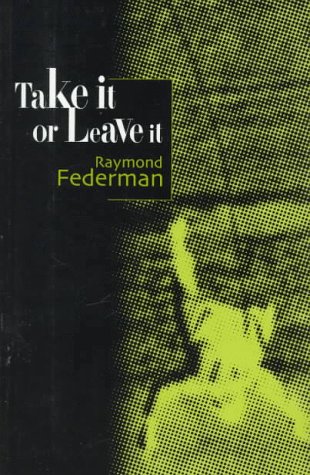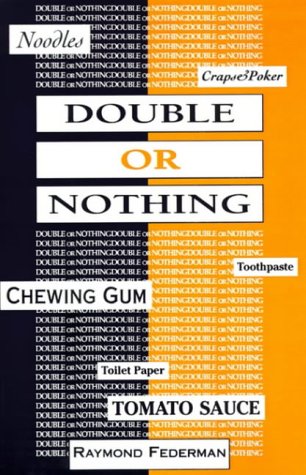
KARLSTAD Conference 2004: Memory, Haunting, Discourse
Workshop:
Memory and potentiality as narrative
strategies in the work of Raymond Federman.

Workshop
frame:
“History is
bankrupt”, Raymond Federman declares in his novel The
Twofold Vibration, suggesting that history, like money, is a
liability in the hands of investors who can lose it, regain it, invest
in it,
sell it, buy it, conceal it, reveal it, make it available. All these
fluctuating and conflicting aspects of history are recurrent in
Federman’s
fictional work and point to a world of potentiality. As a subject in a
historical
context, one relates to history’s potential by exhibiting what Federman
calls a
“sense of historical possibilities”. All Federman’s works are saturated with making history,
and particularly personal history, an active part of memory which never
settles
with ‘solid’ or ‘simple’ facts, but rather develops possibilities and
potentialities around factual certainties. “I am often asked”, Federman
writes,
“as a survivor of the Holocaust and as a writer: ‘Federman tell us the
story of
your survival’. And I can only answer: ‘There is no story. My life is
the
story. Or rather, the story is my life.’” Federman’s fictional work is concerned with
construing variations on statements such as these, which mark a demand
for
distinguishing history from story, reality from fiction. Federman’s
capacity to
think historically is enforced in the idea of remembrance as narrative
strategy: one writes in order to remember, and one remembers in order
to be
able to reveal. “It is necessary to speak”, he furthermore says, “to
write, and
keep on speaking and writing (lest we forget) about the Jewish
Holocaust during
the Nazi period even if words cannot express this monstrous event. It
is
impossible to speak or write about the Holocaust because words cannot
express
this monstrous event.” For Federman therefore, history is a dialectical
bind,
which involves a both necessary and impossible transmission of these
haunting
memories. Federman’s notion of history is not defined by a rejection of
it as
an ideology but by creating a mode of discourse in which history is
open to
possibilities. French born writer and
critic Raymond Federman is best known as a practitioner and theorist of
experimental fiction and as the inventor of terms such as ‘surfiction’
and
‘critifiction’, both denoting a type of literature where literary
theory and
practice meet in an acutely self aware form of historiographic
metafiction. This paper is concerned both
with Federman’s experimental style and with the playful representation
of
memory and history and its consequences in his 1981 novel, The
Twofold Vibration. The novel poses questions about the
intersections between political activism, idealism and exploitation,
and
popular culture and history. In the novel a character
known only as ‘the old man’ (one of many Federman alter egos in the
book)
accidentally involves himself in a campus demonstration in Buffalo, New
York,
in the late 1960s. He performs what amounts to an acte
gratuite by hurling a bicycle at a policeman, and from there
he becomes propelled by events beyond his control into a role as a
political
activist/celebrity. The pace picks up when a thinly veiled Jane
Fonda-like
character, June Fanon, chooses to champion the cause of the “Buffalo
45”, of
whom ‘the old man’ is cast as a leader by the media. As casually as
‘the old
man’ hurled the bicycle, the two ‘activists’ fall for each other’s
charms and
decide to “forget about the revolution” and elope together to Europe. This apparently
irresponsible act is further motivated by ‘the old man’s’ assertion
that “most
of us live our politics in the past” (to which Fanon replies: “Or in
the
future”), and, what is more, that “political understanding is but a
series of
second thoughts”. Both characters escape the historical moment of the
1960s without
qualms: Fonda/Fanon already planning the emotional depths of future
film roles
that have yet to be created for her (for instance, her Oscar winning
performance in 1978 in Coming Home);
‘the old man’ dreaming of repeating a fabulous winning streak at the
roulette
tables of Monte Carlo. In the greater scheme of the novel, both these
future
and past reminiscences are presented as far more substantial than the
characters’ present 1960s counter cultural activism. The couple embark
on a
trip which gradually evolves into a journey of remembrance for ‘the old
man’,
taking him from the casino tables to the Nazi death camps that are
symbolically
figured as a birthplace for his second, surplus life in America. This paper therefore presents
a twofold
thesis: ‘The old man’s’ accidental political radicalism leads to a
confrontation with the haunting past, which ultimately is redeemed in
an
effective working through of trauma; whereas Fonda/Fanon’s carefully
designed,
but futile activism leads nowhere but back to Hollywood, simply because
it does
not result in any exoneration of a past burden or guilt, but merely
serves as a
future oriented publicity strategy. Story telling, for Raymond Federman, is an act
of provocation which engages the reader in a refashioning of history by
constructing a narrative which transforms memory, time, and place into
a potential
- a topos where the act of narrating in the first person plural becomes
the
memory of history. When one of Federman’s narrators “reveals” in The Twofold Vibration: “It’s all there
you schmucks, inside the words, teller and told, survivors and victims
unified
into a single design”, he suggests that the reality of an event becomes
concrete only into the potentiality of words. This paper argues that
one of the
functions of the use of the first person plural is to ‘plot’ against
traditional modes of narration, which merely ‘set up’ and ‘frame’ the
reader’s
expectation. The interplay between first, second, and third person
narrators,
culminating in the collective narrator/narratee of the first person
plural,
further indicates that the reader’s referential field itself becomes a
potential topos for situating history in memory.
Bent Sørensen
Camelia Elias
Jesper Christensen
Lisbeth R. Pedersen
Federman-quotations
from the four lectures

H(a)unting Potentialities: Federman Frenzies
Hypothetical
Past, Present and Future – Narrative Strategies in Raymond Federman’s
Writing
As the only member
of
his close family, French-American writer and critic and Raymond
Federman
survived the Holocaust. Ever since, Federman has attempted to come to
terms
with this horrible historical fact through his writings. Both his
poetry and
prose are radical as regards the manner of narration, form, typesetting
and
layout. However, to Federman writing is not primarily a matter of
experimenting.
Rather, it is the only way for him to come to terms with living when so
many
others were exterminated.
Reading Federman’s texts is to witness a constant challenge of the
conventional
relationships between the concepts of both historical facts as well as
fictional
facts. As Federman cautions the reader at the onset of his 1976 novel, Take It or Leave It: “All characters and
places in this book are real, they are made of words, and therefore any
resemblance with anything written (published or unpublished) is purely
coincidental”. Reality depends on how you write and narrate it.
This paper suggests a methodological approach to a major narrative
strategy in Federman’s historiographic metafiction. An
examination of the use
of hypothetical notions in his texts will serve as insights into
Federman’s
perception of the potentiality of writing versus the narration of one’s
history.
Concerning the historical past, Federman’s approach to his narration is
an
attempt at uncovering the matter of Fate: Surviving while others have
perished.
The
overall purpose
of this paper is to investigate how Federman uses the forwarding
passages of
hypothetical notions in texts to clarify his strained relationship with
the
facts of linear historical time. To Federman, writing history is not
merely a
matter of words, it is matter of how life and death — and reality —
could
potentially have turned out.

Lisbeth
R.
Pedersen:
Frame-breaking and concrete prose in the works of
Raymond Federman.
Raymond Federman’s two novels Double or Nothing (1971) and Take
It or Leave It (1976) are highly experimental and provocative both
in terms
of their style and the narrative strategies employed. With these
novels,
Federman presents us with two somewhat thinly disguised versions of his
autobiography while, at the same time, he tells us the story of telling
stories
and the problems that arise during this process. Both novels can
therefore be
seen as typical examples of metafiction. Hence, the novels serve a
twofold
function: On the one hand, they can be seen as Federman’s attempt of
coming to
terms with the fact that he is the only member of a Jewish family to
survive
the Holocaust. On the other hand, the novels function as a critique of
traditional literary conventions and emphasise the limitations that
language
imposes on us. Federman seems to suggest that such conventions do not
suffice
as a means of conveying or explaining the horrors he underwent.
The purpose of this paper is to
investigate some of the metafictional strategies employed by Federman.
Through
the prominent and very playful use of concrete prose and abstract
typographical
shapes, the materiality of Federman’s books is foregrounded to such an
extent
that their projected “realities” are constantly disrupted. In doing so,
Federman presents us with a deep ontological cut between the physical
reality
of the actual ink shapes on the page and the world(s) projected by
words.
However, this is not the only ontological problem that his novels
exhibit.
Through a thorough mixing and merging of different possible worlds
within the
narrative hierarchy, it becomes almost impossible for the reader to
distinguish
between and keep track of the many fictional universes presented within
the
discourses. Consequently, the levels collapse and Federman’s aim “to
tell a
story that cancels itself as it goes” is fulfilled.
This paper, therefore, argues that Federman’s
pronounced use of radical frame-breaking and concrete prose is perhaps
the only
approach for him if he is to at least attempt to render and understand
the
horrors and meaninglessness of the Holocaust. The “unutterable” is thus
expressed by way of verbal icons imitating the “real” object (or
process) as
well as chaotically structured narrative hierarchies that deviate from
and mock
traditional literary conventions.
